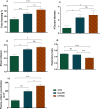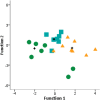Stressor controllability modulates the stress response in fish
- PMID: 34348667
- PMCID: PMC8336412
- DOI: 10.1186/s12868-021-00653-0
Stressor controllability modulates the stress response in fish
Abstract
Background: In humans the stress response is known to be modulated to a great extent by psychological factors, particularly by the predictability and the perceived control that the subject has of the stressor. This psychological dimension of the stress response has also been demonstrated in animals phylogenetically closer to humans (i.e. mammals). However, its occurrence in fish, which represent a divergent vertebrate evolutionary lineage from that of mammals, has not been established yet, and, if present, would indicate a deep evolutionary origin of these mechanisms across vertebrates. Moreover, the fact that psychological modulation of stress is implemented in mammals by a brain cortical top-down inhibitory control over subcortical stress-responsive structures, and the absence of a brain cortex in fish, has been used as an argument against the possibility of psychological stress in fish, with implications for the assessment of fish sentience and welfare. Here, we have investigated the occurrence of psychological stress in fish by assessing how stressor controllability modulates the stress response in European seabass (Dicentrarchus labrax).
Results: Fish were exposed to either a controllable or an uncontrollable stressor (i.e. possibility or impossibility to escape a signaled stressor). The effect of loss of control (possibility to escape followed by impossibility to escape) was also assessed. Both behavioral and circulating cortisol data indicates that the perception of control reduces the response to the stressor, when compared to the uncontrollable situation. Losing control had the most detrimental effect. The brain activity of the teleost homologues to the sensory cortex (Dld) and hippocampus (Dlv) parallels the uncontrolled and loss of control stressors, respectively, whereas the activity of the lateral septum (Vv) homologue responds in different ways depending on the gene marker of brain activity used.
Conclusions: These results suggest the psychological modulation of the stress response to be evolutionary conserved across vertebrates, despite being implemented by different brain circuits in mammals (pre-frontal cortex) and fish (Dld-Dlv).
Keywords: Controllability; Cortisol; Dorsolateral pallium; Fish welfare; Immediate early genes; Stress.
© 2021. The Author(s).
Conflict of interest statement
We declare we have no competing interests.
Figures




References
-
- Maier SF, Seligman ME. Learned helplessness: theory and evidence. J Exp Psychol Gen. 1976;105:3–46. doi: 10.1037/0096-3445.105.1.3. - DOI
Publication types
MeSH terms
Substances
LinkOut - more resources
Full Text Sources
Medical
Miscellaneous

